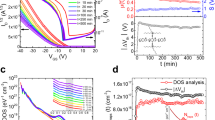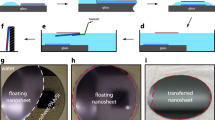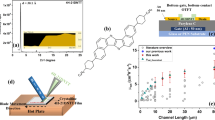Abstract
Electronic devices based on organic semiconductors offer an attractive alternative to conventional inorganic devices due to potentially lower costs, simpler packaging and compatibility with flexible substrates1,2. As is the case for silicon-based microelectronics, the use of complementary logic elements—requiring n- and p-type semiconductors whose majority charge carriers are electrons and holes, respectively—is expected to be crucial to achieving low-power, high-speed performance. Similarly, the electron-segregating domains of photovoltaic assemblies require both n- and p-type semiconductors3,4,5. Stable organic p-type semiconductors are known6, but practically useful n-type semiconductor materials have proved difficult to develop, reflecting the unfavourable electrochemical properties of known, electron-demanding polymers7. Although high electron mobilities have been obtained for organic materials, these values are usually obtained for single crystals at low temperatures, whereas practically useful field-effect transistors (FETs) will have to be made of polycrystalline films that remain functional at room temperature. A few organic n-type semiconductors that can be used in FETs are known, but these suffer from low electron mobility, poor stability in air and/or demanding processing conditions8,9,10. Here we report a crystallographically engineered naphthalenetetracarboxylic diimide derivative that allows us to fabricate solution-cast n-channel FETs with promising performance at ambient conditions. By integrating our n-channel FETs with solution-deposited p-channel FETs, we are able to produce a complementary inverter circuit whose active layers are deposited entirely from the liquid phase. We expect that other complementary circuit designs11 can be realized by this approach as well.
This is a preview of subscription content, access via your institution
Access options
Subscribe to this journal
Receive 51 print issues and online access
$199.00 per year
only $3.90 per issue
Buy this article
- Purchase on Springer Link
- Instant access to full article PDF
Prices may be subject to local taxes which are calculated during checkout





Similar content being viewed by others
References
Matters, M. et al. Organic field-effect transistors and all-polymer integrated circuits. Opt. Mater. 12, 189– 197 (1999).
Drury, C. J., Mutsaers, C. M. J., Hart, C. M., Matters, M. & de Leeuw, D. M. Low-cost all-polymer integrated circuits. Appl. Phys. Lett. 73, 108– 110 (1998).
Yamaguchi, Y., Fujiyama, T. & Yokoyama, M. Bipolar-charge-transporting organic photoconductors. J. Appl. Phys. 70, 855– 859 (1991).
Panayotatos, P. Recent advances in optimally designed p-n organic semiconductor solar cells. IEEE Photovoltaic Specialists Conf. 19, 889–894 (1987).
Fox, M. A. Polymeric and supramolecular arrays for directional energy and electron transport over macroscopic distances. Acc. Chem. Res. 25, 569–574 (1992).
Li, W., Katz, H. E., Lovinger, A. J. & Laquindanum, J. G. Field-effect transistors based on thiophene hexamer analogues with diminished electron donor strength. Chem. Mater. 11, 458–465 (1999).
de Leeuw, D. M., Simenon, M. M. J., Brown, A. R. & Einerhand, R. E. F. Stability of n-type doped conducting polymers and consequences for polymeric microelectronic devices. Synth. Met. 87, 53–58 (1997).
Haddon, R. C. et al. C60 thin film transistors. Appl. Phys. Lett. 67, 121–123 ( 1995).
Laquindanum, J. G., Katz, H. E., Dodabalapur, A. & Lovinger, A. J. n-Channel organic transistor materials based on naphthalene frameworks. J. Am. Chem. Soc. 118, 11331–11332 (1996).
Bao, Z., Lovinger, A. J. & Brown, J. New air-stable n-channel organic thin film transistors. J. Am. Chem. Soc. 120, 207– 208 (1998).
Crone, B. et al. Large-scale complementary integrated circuits based on organic transistors. Nature 403, 521– 523 (2000).
Rademacher, A., Maerkle, S. & Langhals, H. Lösliche Perylen-Fluoreszenzfarbstoffe mit hoher Photostabilität. Chem. Ber. 115, 2927 –2934 (1982).
Horowitz, G. et al. Growth and characterization of sexithiophene single crystals. Chem. Mater. 7, 1337–1341 (1995).
Siegrist, T. et al. The crystal structure of the high-temperature polymorph of α-hexathienyl (α-6T/HT). J. Mater. Res. 10, 2170 –2173 (1995).
Fichou, D., Bachet, B., Demanze, F., Billy, I. & Horowitz, G. Growth and structural characterization of the quasi-2D single crystal of α-octithiophene (α-8T). Adv. Mater. 8, 500–504 ( 1996).
Horowitz, G. Organic field-effect transistors. Adv. Mater. 10, 365–376 (1998).
Wiederrecht, G. P., Miemczyk, M. P., Svec, W. A. & Wasielewski, M. R. Photorefractivity in nematic liquid crystals doped with a conjugated polymer: mechanisms for enhanced charge transport. Chem. Mater. 11, 1409–1412 (1999).
Katz, H. E. et al. Facile deposition processes for semiconducting molecular solids. Proc. Mater. Res. Soc. (in the press).
Dodabalapur, A., Laquindanum, J., Katz, H. E. & Bao, Z. Complementary circuits with organic transistors. Appl. Phys. Lett. 69, 4227–4229 ( 1996).
Acknowledgements
We thank Z. Bao, R. Raju, E. Chandross and J. Rogers for discussions. H.E.K. gratefully acknowledges discussions with the late Professor B. Weintraub.
Author information
Authors and Affiliations
Corresponding author
Rights and permissions
About this article
Cite this article
Katz, H., Lovinger, A., Johnson, J. et al. A soluble and air-stable organic semiconductor with high electron mobility . Nature 404, 478–481 (2000). https://doi.org/10.1038/35006603
Received:
Accepted:
Issue Date:
DOI: https://doi.org/10.1038/35006603
This article is cited by
-
Organic and Hybrid Diode Features of an n-Type 1,8-Naphthalimide Derivative
Journal of Electronic Materials (2023)
-
Significant Detectivity Enhancement of Broad Spectral Organic–Inorganic Hybrid Photodiodes by C60 Film as Hole-Blocking Layer
Nanoscale Research Letters (2022)
-
A systematic review on 1,8-naphthalimide derivatives as emissive materials in organic light-emitting diodes
Journal of Materials Science (2022)
-
Organic Devices: Fabrication, Applications, and Challenges
Journal of Electronic Materials (2022)
-
Effectively modulating thermal activated charge transport in organic semiconductors by precise potential barrier engineering
Nature Communications (2021)
Comments
By submitting a comment you agree to abide by our Terms and Community Guidelines. If you find something abusive or that does not comply with our terms or guidelines please flag it as inappropriate.



